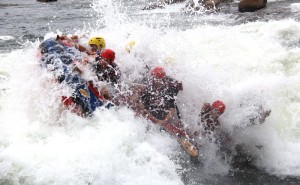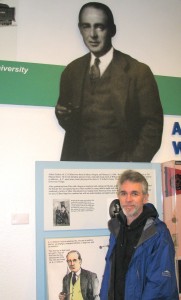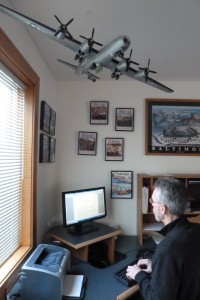It’s only when a season ends that I am able to properly reflect upon it. Since we’re officially into fall, summer is open for mental business. As for the summer of 2013, I am proclaiming it “The Summer of the Biting.”
It began with a bite, a real bite, by a real dog. It happened while hiking, one of my favorite pastimes. I had wandered off the main trail onto a path that looked to be getting some new wear. I had heard about a homeless camp nearby and thought I would investigate.
The path wound through a stand of fir and scraggly oak trees. About a quarter mile in, I heard a man’s voice. “Come on up,” he called.
The path led uphill to tents – three of them – spread across a small clearing. “Don’t mean to intrude,” I said as I closed on the camp and saw a bearded, middle-aged man standing by one of the tents. Then I heard the dog.
It barked furiously, flew out of one of the tents, and ran straight at me. It was a pit bull, thick and powerful, and not the least bit happy. The man grabbed for it, but it darted from him, raced back behind the tent, and charged me from a different angle.
I braced myself and planted my walking stick in front of me, hoping to deter the dog. Instead, the stick enraged it and the dog lunged and snapped at it. I backed away, shouting at the man to get a hold of his dog.

He scrambled for the dog, but it escaped him again and came straight at me barreling past the stick, lunging, and ripping into my leg with its teeth. I swung the stick hard, but the dog was already retreating, barking, and snarling all the way.
I grabbed my bear mace (which I should have done earlier), snapped off the safety and was ready for another charge. “Get a hold of your dog, or I’ll spray it!” I shouted.
“That’ll be the last thing you do!” the man retorted.
Oh, great, I thought, the guy’s not only got a vicious dog; he’s got a gun too. As I slowly backed away, the dog retreated and the man grabbed and tied it. The pain in my leg felt searing and I lifted my shorts to view the wound. It didn’t look too bad – the skin wasn’t torn open – but there were holes, teeth marks, and blood.
And that wasn’t the end of it, either. There was more: getting seen by a doctor (who examined too little and charged too much), reporting to the animal authorities, spending days trying to track down the dog’s immunization records. Money, time, and stress, but no infection. And no rabies.
If only that was the end to the biting, I wouldn’t be writing this. But it wasn’t. Life takes bites of its own. Less than two weeks after the dog encounter, I was scheduled to fly to Africa to meet my son for a once-in-a-lifetime trip. I missed the flight (another story in itself). The following day, as I drove to the airport in the early morning, a deer ran at me and smashed into my car. The deer disappeared into the darkness and the damage to my car substantial, but nothing was going to stop me from boarding the plane for the 28-hour journey. The events leading up to this point had me shaken and wondering if they might be a preview of what was to come.
They were not. In fact, during my time in Africa I learned more about biting – that I can bite, too. I can take bites out of life by stretching my limits, moving out of my comfort zone, and feeling the joy that comes with it. Like, hiking three-and-a-half hours into Bwindi Impenetrable Forest of Uganda, up and down steep slopes, through dense foliage, and along ant-infested trails to catch a glimpse of endangered mountain gorillas. Not only did we glimpse these gentle giants, we got close enough to smell them, hear their subtle sounds, and see the tiny insects that swarmed them. An incredible experience!
So were the visits to two of the best animal reserves on the planet, despite the interminable bus rides over dusty, brain-jarring, and dangerous plowed pathways they call roads. The reward was viewing magnificent beings: giraffes, elephants, wildebeests, leopards, lions, Cape buffalo, crocodile, hippos, rhinos, warthogs, chimpanzees, baboons, and a rich variety of beautiful birds. Spotting these creatures is a joy surpassed only by the opportunity to watch them in their natural environment.
And then there was the rafting on the mighty Nile River, which courses more than 4,000 miles, making it the world’s longest. We met the river early in its journey, near Lake Victoria, where it demonstrates its many moods, from slow and sullen to fast and ferocious. We entered the rapids at the river’s mercy, having prepared but not planned for the fury to come. And come it did, bouncing the raft, turning and twisting it, and finally flipping it over and dragging us under with its might. Resistance is impossible so you wait patiently for the river to release you and allow you back to the surface. The breath you took when you break that surface is unlike any other, and the clouds and the sky never look more wonderful.

Summer has faded now and fall colors dot the landscape. I doubt a dog will ever bite me again, but I’m certain I’ll be bitten by life. I know that. I also know that I will do some biting, too. And that, I have decided, will keep life interesting.








